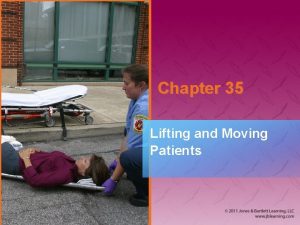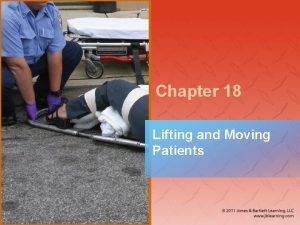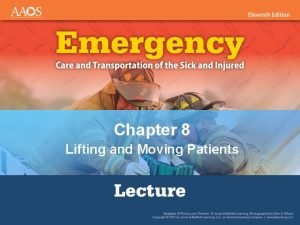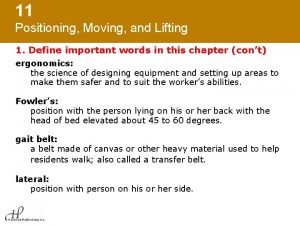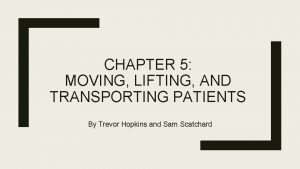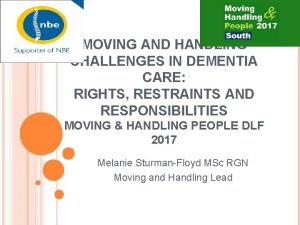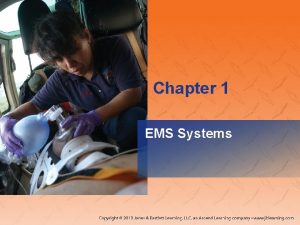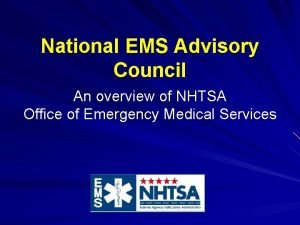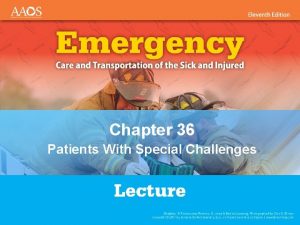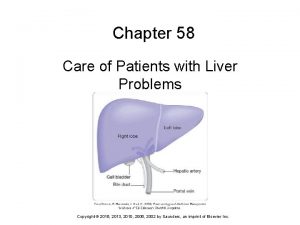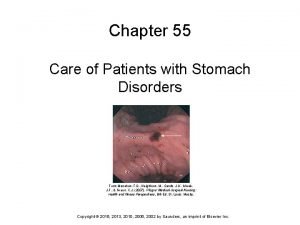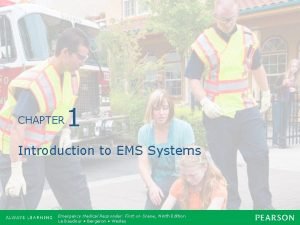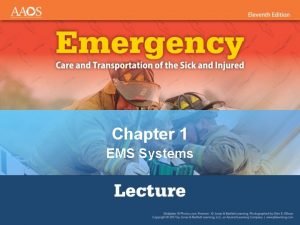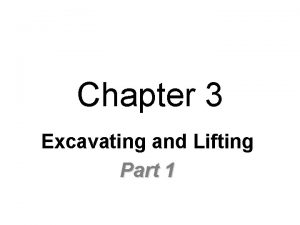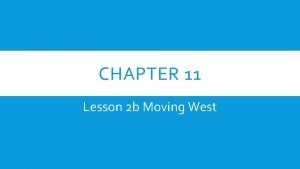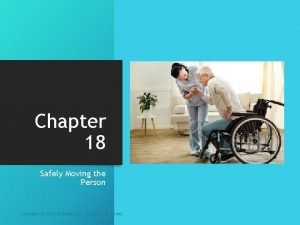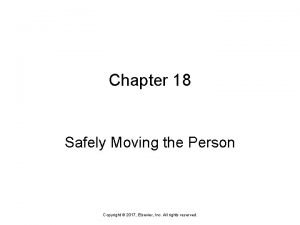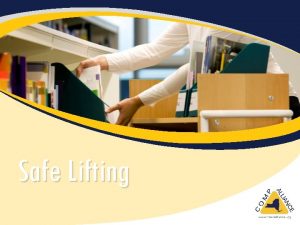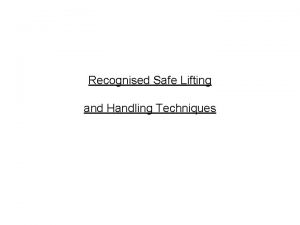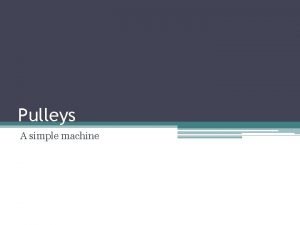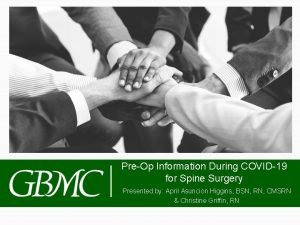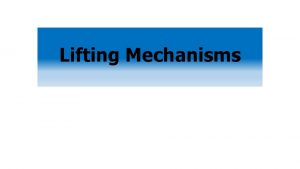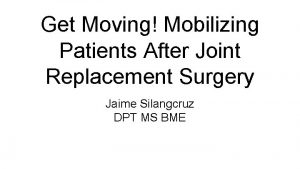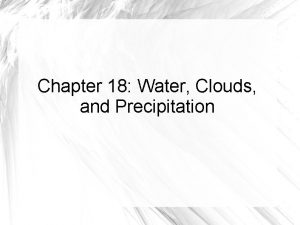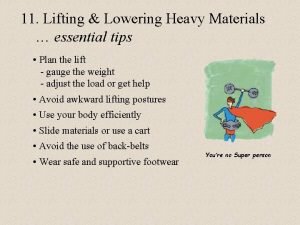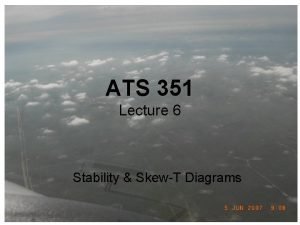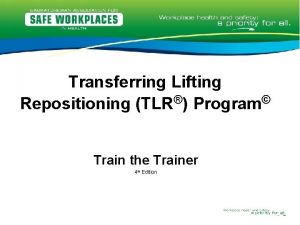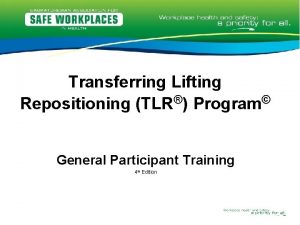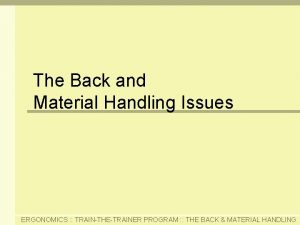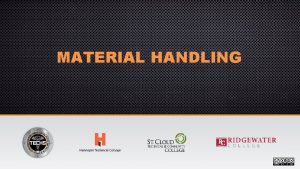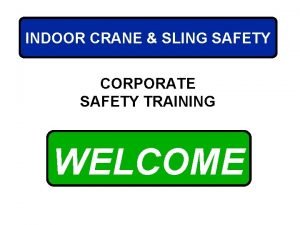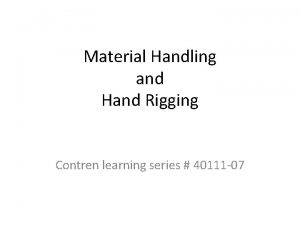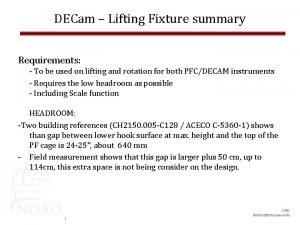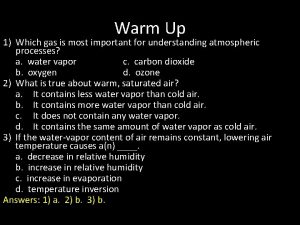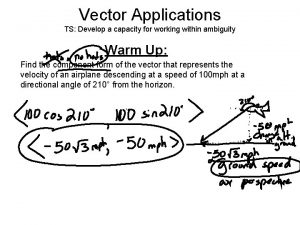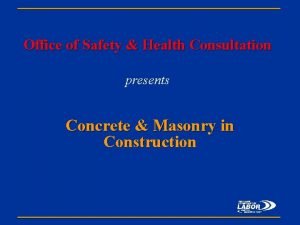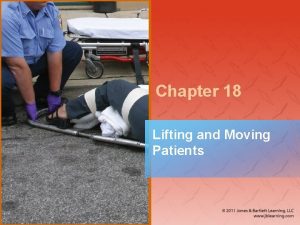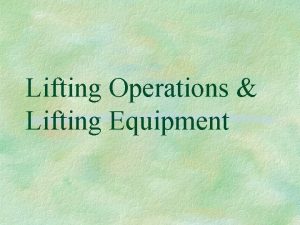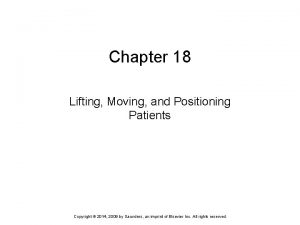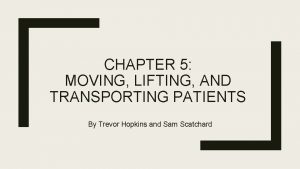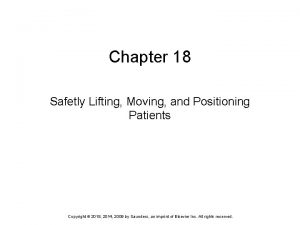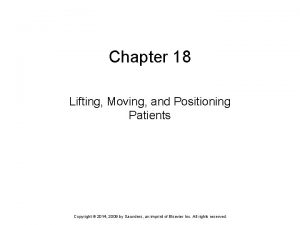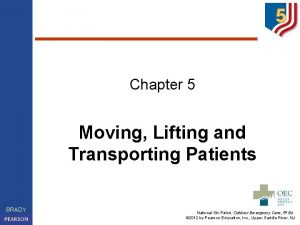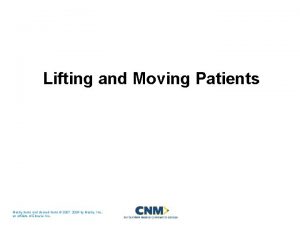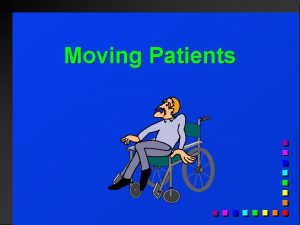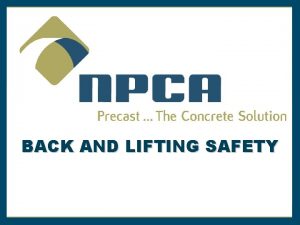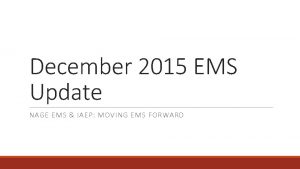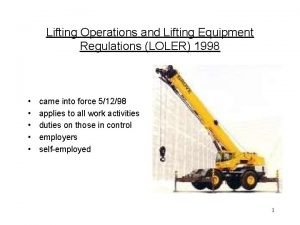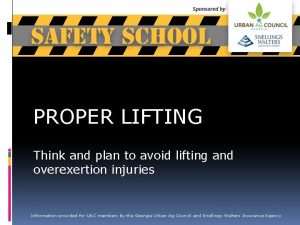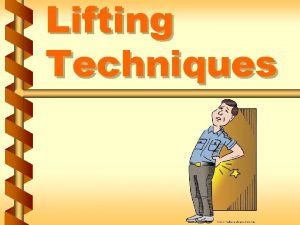Chapter 3 Lifting and Moving Patients National EMS




































































- Slides: 68

Chapter 3: Lifting and Moving Patients

National EMS Education Standard Competencies (1 of 3) Preparatory Uses simple knowledge of the emergency medical services (EMS) system, safety/wellbeing of the emergency medical responder (EMR), and medical/legal issues at the scene of an emergency while awaiting a higher level of care.

National EMS Education Standard Competencies (2 of 3) Workforce Safety and Wellness • Standard safety precautions • Personal protective equipment • Stress management – Dealing with death and dying • Prevention of response-related injuries • Lifting and moving patients

National EMS Education Standard Competencies (3 of 3) EMS Operations Knowledge of operational roles and responsibilities to ensure safe patient, public, and personnel safety.

Introduction • As an EMR, you must – Analyze the emergency situation. – Quickly evaluate the patient’s condition. – Carry out effective, lifesaving emergency medical procedures. • These procedures may include lifting, moving, or positioning patients.

General Principles (1 of 3) • Every time you move a patient, keep general guidelines in mind: – Do no further harm to the patient. – Move the patient only when necessary. – Move the patient as few times as possible. – Move the patient’s body as a unit. – Use proper lifting and moving techniques. – Have one rescuer give commands.

General Principles (2 of 3) • Also consider these recommendations: – Delay moving the patient, if possible, until additional EMS personnel arrive. – Treat the patient before moving him or her unless the patient is unsafe. – Do not step over the patient. – Explain to the patient what you are doing.

General Principles (3 of 3) • Keep the rules of good body mechanics in mind: – Know your own physical limitations. – Keep yourself balanced. – Maintain a firm footing. – Lift and lower the patient by bending your legs, not your back. – Try to keep your arms close to your body for strength and balance. – Move the patient as few times as possible.

Recovery Position • Unconscious patients who have not suffered trauma should be placed in a sidelying or recovery position. – Helps keep the airway open – Allows secretions to drain from the mouth © Jones & Bartlett Learning. Courtesy of MIEMSS.

Body Mechanics (1 of 3) • Improper lifting or moving techniques can result in injury to you or to the patient. • Good body mechanics – Use the strength of the large muscles in your legs to lift patients instead of using your back muscles. © Jones & Bartlett Learning. Courtesy of MIEMSS.

Body Mechanics (2 of 3) • Good body mechanics (cont’d) – Keep your back straight as you lift. – Lift without twisting your body. – Ensure that you have firm footing before you start to lift or move a patient. – Assess the weight of the patient. – Know your physical limitations.

Body Mechanics (3 of 3) • Good body mechanics (cont’d) – Call for additional personnel if needed. – Communicate with the other members of the lifting team. – Practice lifts and moves.

Emergency Movement of Patients • Move a patient immediately in the following situations: – Danger of fire, explosion, or structural collapse exists. – Hazardous materials are present. – The emergency scene cannot be protected. – It is otherwise impossible to gain access to other patients who need lifesaving care. – The patient has experienced cardiac arrest.

Emergency Drags (1 of 8) • Clothes drag – Simplest way to move a patient – Grasp the patient’s clothing in the neck and shoulder area. © Jones & Bartlett Learning. Courtesy of MIEMSS. – Rest the patient’s head on your arms. – Drag the patient out of danger.

Emergency Drags (2 of 8) • Cardiac patients and the clothes drag – If the room in which you find the patient is not large enough, move the patient. – Drag the patient from the tight space and quickly move furniture out of the way. – Provide cardiopulmonary resuscitation (CPR). © American Academy of Orthopaedic Surgeons.

Emergency Drags (3 of 8) • Blanket drag – Use this drag if the patient is not dressed or is dressed in clothing that could tear easily. © Jones & Bartlett Learning. Courtesy of MIEMSS. – Place the rug on the floor and roll the patient onto it. – Pull the patient to safety by dragging the rug.

Emergency Drags (4 of 8) • Arm-to-arm drag – Place your hands under the patient’s armpits from the back and grasp the patient’s forearms. – Used to move a heavy patient – Offers some protection for the head and neck © Jones & Bartlett Learning. Courtesy of MIEMSS.

Emergency Drags (5 of 8) • Firefighter drag – Tie the patient’s wrists together. – Get down on your hands and knees and straddle the patient. – Pass the patient’s tied hands around your neck, straighten your arms, and drag the patient across the floor. © Jones & Bartlett Learning. Courtesy of MIEMSS.

Emergency Drags (6 of 8) • Emergency drag from a vehicle – One rescuer • Grasp the patient under the arms and cradle the patient’s head between your arms. • Pull the patient down into a horizontal position as you ease him or her from the vehicle.

Emergency Drags (7 of 8) © Jones & Bartlett Learning. Courtesy of MIEMSS.

Emergency Drags (8 of 8) • Emergency drag from a vehicle (cont’d) – Two or more rescuers • One rescuer supports the patient’s head and neck while the second rescuer moves the patient by lifting under the arms. • The patient is removed with the head and neck stabilized in a neutral position. • Use a long backboard if time permits.

Carries for Nonambulatory Patients (1 of 9) • Two-person extremity carry © Jones & Bartlett Learning. Courtesy of MIEMSS. – Rescuer One reaches under the patient’s arms and grasps the patient’s wrists. – Rescuer Two reaches around the legs and grasps the patient behind the knees. – The two rescuers stand up and carry the patient away.

Carries for Nonambulatory Patients (2 of 9) • Two-person seat carry – The rescuers kneel on opposite sides of the patient near the patient’s hips. – The rescuers raise the patient to a sitting position and link arms behind the patient’s back. – The rescuers place the other arm around the patient’s knees and link with each other. – No equipment is required.

Carries for Nonambulatory Patients (3 of 9) © Jones & Bartlett Learning. Courtesy of MIEMSS.

Carries for Nonambulatory Patients (4 of 9) • Cradle-in-arms carry – Used by one rescuer to carry a child – Kneel beside the patient and place one arm around the back and the other under the thighs. © Jones & Bartlett Learning. Courtesy of MIEMSS. – Lift slightly and roll the child into the hollow formed by your arms and chest.

Carries for Nonambulatory Patients (5 of 9) • Two-person chair carry – Rescuer One stands behind the seated patient and grasps the back of the chair. – Rescuer One tilts the chair backward so that rescuer Two can grasp the front legs. © Jones & Bartlett Learning. Courtesy of MIEMSS. – Rescuer One gives the command to lift and walk away.

Carries for Nonambulatory Patients (6 of 9) • Pack-strap carry – Back into the patient as he or she is standing. – Grasp the patient’s wrists and cross the arms over your chest. – Pull the patient onto your back. – Bend forward to lift the patient, stand up, and walk away. © Jones & Bartlett Learning. Courtesy of MIEMSS.

Carries for Nonambulatory Patients (7 of 9) • Direct ground lift – Used to move a patient who is on the ground or the floor to an ambulance stretcher – Should be used only for those patients who have not sustained a traumatic injury – The steps for performing the direct ground lift are described in Skill Drill 3 -1.

Carries for Nonambulatory Patients (8 of 9) • Transferring a patient from bed to stretcher – Place the stretcher next to the bed. – Loosen the bottom sheet underneath the patient or log roll the patient onto a blanket. – Reach across the stretcher and grasp the sheet and blanket firmly at the patient’s head, chest, hips, and knees. – Slide the patient onto the stretcher.

Carries for Nonambulatory Patients (9 of 9) © Jones & Bartlett Learning. Courtesy of MIEMSS.

Walking Assists for Ambulatory Patients (1 of 2) • One-person walking assist – Help the patient stand. – Have the patient place one arm around your neck and hold the patient’s wrist. – Put your free arm around the patient’s waist and help the patient to walk. © Jones & Bartlett Learning. Courtesy of MIEMSS.

Walking Assists for Ambulatory Patients (2 of 2) • Two-person walking assist – Useful if the patient cannot bear weight – The two rescuers completely support the patient. © Jones & Bartlett Learning. Courtesy of MIEMSS.

Wheeled Ambulance Stretchers (1 of 2) • One of the most commonly used EMS devices • Can be raised and lowered to different heights • Have belts to secure the patient © Jones & Bartlett Learning.

Wheeled Ambulance Stretchers (2 of 2) • Stretchers can be rolled or carried by two or four people. – If the surface is smooth, a wheeled stretcher can be rolled with one person guiding the head and one person pulling the foot end. – If the loaded stretcher must be carried, it is best to use four people, one at each corner. – If the stretcher must be carried through a narrow area, only two people will fit.

Portable Stretchers • Used when the wheeled stretcher cannot be moved into a small space • Smaller and lighter than a wheeled stretcher • Can be carried in the same ways that a wheeled stretcher is carried © American Academy of Orthopaedic Surgeons.

Stair Chairs • Portable moving device that is used to carry a patient in a sitting position – Useful for patients who are short of breath or who are more comfortable sitting – Small, lightweight, and easy to carry – Do not use with patients who have experienced any type of trauma. © Jones & Bartlett Learning. Courtesy of MIEMSS.

Immobilization Devices (1 of 5) • Used to immobilize patients who have neck or back injuries • Used to assist in lifting patients and immobilizing lower extremity injuries • Long backboards – Used for moving patients who have experienced trauma – Useful for lifting and moving patients who are in small places

Immobilization Devices (2 of 5) • Long backboards (cont’d) – Made of plastic or fiberglass – Patients must be secured with straps. – If the patient has sustained back or neck injuries, the head should be immobilized. © Jones & Bartlett Learning. Courtesy of MIEMSS.

Immobilization Devices (3 of 5) • Short backboard devices – Used to immobilize the head and spine of patients found in a sitting position © Jones & Bartlett Learning. Courtesy of MIEMSS. – Usually made of plastic – Some consist of a vest-like garment that wraps around the patient.

Immobilization Devices (4 of 5) • Scoop stretchers – Helpful when moving patients out of small spaces – Do not use for patients with head or spinal injuries. – Follow the steps in Skill Drill 3 -2 for using a scoop stretcher. © Jones & Bartlett Learning. Courtesy of MIEMSS.

Immobilization Devices (5 of 5) • In an emergency situation, use – Wide, sturdy planks – Doors – Ironing boards – Sturdy folding tables – Full-length lawn chair recliners – Surfboards – Snowboards

Treatment of Patients With Suspected Head or Spine Injury • Any time a patient has sustained a traumatic injury, suspect injury to the head, neck, or spine. – Improper treatment can lead to permanent damage or paralysis. – Keep the patient’s head and neck in a neutral position and immobilized.

Applying a Cervical Collar (1 of 2) • Used to prevent excess movement of the head and neck © Jones & Bartlett Learning. Courtesy of MIEMSS. – Soft cervical collars do not provide sufficient support for trauma patients. – Many types of rigid cervical collars are available.

Applying a Cervical Collar (2 of 2) • A cervical collar should be applied before the patient is placed on a backboard. © Jones & Bartlett Learning. Courtesy of MIEMSS.

Movement of Patients Using Backboards (1 of 2) • Patients who should be transported on a backboard include – Any patient who has sustained spinal trauma in a motor vehicle crash or fall – Any person who has sustained gunshot wounds to the trunk

Movement of Patients Using Backboards (2 of 2) • If you suspect the patient has a spinal injury – Move the patient as a unit. – Transport the patient face up (supine). – Keep the patient’s head and neck in a neutral position. – Be sure that all rescuers understand what is to be done before attempting any movement. – Be sure one rescuer gives commands.

Assisting With Short Backboard Devices • After the short backboard device is applied, the patient is carefully placed on a long backboard. • Skill Drill 3 -3 illustrates how one commonly used short backboard device is applied.

Log Rolling (1 of 2) • Primary technique used to move a patient onto a long backboard • Requires a team of four rescuers • Movement technique of choice in all patients with suspected spinal injury • The procedure for the four-person log roll is shown in Skill Drill 3 -4.

Log Rolling (2 of 2) • All patient movement commands have two parts: – A question – The order for movement • Move the patient as a unit. • Keep the patient’s head in a neutral position at all times.

Straddle Lift (1 of 2) • Can be used to place a patient on a backboard if you do not have enough space to perform a log roll © Jones & Bartlett Learning. Courtesy of MIEMSS.

Straddle Lift (2 of 2) • Requires five rescuers – One at the head and neck – One to straddle the shoulders and chest – One to straddle the hips and thighs – One to straddle the legs – One to insert the backboard under the patient • The lift should be practiced often.

Straddle Slide (1 of 2) • In the straddle slide, the patient, rather than the backboard, is moved. © Jones & Bartlett Learning. Courtesy of MIEMSS.

Straddle Slide (2 of 2) • May be useful when the patient is in an extremely narrow space • The rescuers’ positions are the same. – Lift the patient as a unit. – Slide the patient forward about 10 inches at a time. – Each rescuer should lean forward slightly and use a swinging motion to bring the patient onto the board.

Straps and Strapping Techniques (1 of 2) • Every patient who is on a backboard should be strapped down to prevent sliding or slipping. – The straps should be long enough to go around the board and a large patient. – Straps 6 feet to 9 feet long with seatbelt-type buckles work well. © American Academy of Orthopaedic Surgeons.

Straps and Strapping Techniques (2 of 2) • Once the patient is centered on the board, secure the upper torso with straps. • Secure the pelvis and upper legs, using padding as needed. © Jones & Bartlett Learning.

Head Immobilization (1 of 3) • The blanket roll is an improvised device that works well and is readily available. – Fold and roll the blanket as shown in Skill Drill 3 -5. – Stabilization is maintained by the blanket roll, as shown in Skill Drill 3 -6.

Head Immobilization (2 of 3) • Head stabilization must be maintained through the entire procedure. – The blanket roll must be fitted securely against the patient’s shoulders. – Secure the blanket roll to the head with two cravats tied around the blanket roll. – Use two more cravats to bind the head and the blanket roll to the backboard.

Head Immobilization (3 of 3) • Foam blocks are quick to apply and provide good stabilization of the head and neck. © Jones & Bartlett Learning. Courtesy of MIEMSS.

Summary (1 of 4) • General guidelines when moving patients – Do no further harm to the patient. – Move the patient only when necessary. – Move the patient as little as possible. – Move the patient’s body as a unit. – Use proper lifting and moving techniques. – Have one rescuer give commands when moving a patient.

Summary (2 of 4) • Unconscious patients who have not sustained trauma should be placed in the recovery position. • If a patient is on the floor or ground during an emergency situation, you may have to drag the person away from the scene instead of trying to lift and carry the person.

Summary (3 of 4) • Do not lift or move a patient if you suspect a spinal injury, unless it is necessary to remove the patient from a life-threatening situation. • EMS services typically use wheeled ambulance stretchers, portable stretchers, stair chairs, long backboards, short backboards, and scoop stretchers.

Summary (4 of 4) • A cervical collar prevents excessive movement of the head and neck. • Log rolling is the primary technique used to move a patient onto a backboard. • Once a patient has been secured to the backboard, the head and neck must be immobilized.

Review 1. As an EMR, you may injure your back, even if it is straight, if you A. lift with your back bent forward at the hips. B. align your shoulders over your hips. C. hold your hands close to your legs. D. use your leg muscles.

Review Answer: A. lift with your back bent forward at the hips.

Review 2. Patients who should be transported on a backboard include any patient who A. is intoxicated. B. requests it. C. has an upper extremity injury. D. has sustained gunshot wounds to the trunk.

Review Answer: D. has sustained gunshot wounds to the trunk.

Review 3. Head immobilization A. is not required in all patients who are placed on a backboard. B. can be achieved using head blocks or towel rolls. C. does not need to be maintained during the backboarding process. D. can be properly accomplished only with special equipment.

Review Answer: B. can be achieved using head blocks or towel rolls.
 You may injure your back if you lift
You may injure your back if you lift Straddle slide technique
Straddle slide technique Emergency move vs rapid extrication
Emergency move vs rapid extrication Principles of lifting and moving patients
Principles of lifting and moving patients Positioning moving and lifting
Positioning moving and lifting Tools & tackles
Tools & tackles High fowlers position
High fowlers position Wendylett sheets 1 carer
Wendylett sheets 1 carer National ems education standards
National ems education standards National ems advisory council
National ems advisory council Patients with special challenges
Patients with special challenges Chapter 58 care of patients with liver problems
Chapter 58 care of patients with liver problems Chapter 55 care of patients with stomach disorders
Chapter 55 care of patients with stomach disorders Chapter 1 ems systems
Chapter 1 ems systems Ems systems chapter 1
Ems systems chapter 1 Chapter 9 expanding markets and moving west
Chapter 9 expanding markets and moving west Chapter 9 expanding markets and moving west
Chapter 9 expanding markets and moving west Chapter 9 expanding markets and moving west
Chapter 9 expanding markets and moving west National unification and the national state
National unification and the national state Mechanical drives and lifting machines n2
Mechanical drives and lifting machines n2 Excavating and lifting equipment
Excavating and lifting equipment 10 patients' rights
10 patients' rights Safe staffing ratios: benefiting nurses and patients
Safe staffing ratios: benefiting nurses and patients Medicare improvements for patients and providers act
Medicare improvements for patients and providers act Chapter 30 section 1 moving toward conflict
Chapter 30 section 1 moving toward conflict Moving toward conflict chapter 22 section 1
Moving toward conflict chapter 22 section 1 Chapter 11 lesson 2 moving west
Chapter 11 lesson 2 moving west Chapter 19 safely transferring the person
Chapter 19 safely transferring the person Chapter 18 safely moving the person
Chapter 18 safely moving the person Chapter 18 safely moving the person
Chapter 18 safely moving the person The multimodal text big ed mona
The multimodal text big ed mona Orthodox lifting in nursing
Orthodox lifting in nursing Ergonomic lifting techniques
Ergonomic lifting techniques Trunk kinetic lift
Trunk kinetic lift Simple machines elevator
Simple machines elevator Spinal precautions blt
Spinal precautions blt Simple vex elevator lift
Simple vex elevator lift Frontal lifting
Frontal lifting Frontal lifting
Frontal lifting Total knee replacement
Total knee replacement What's happening in the picture
What's happening in the picture Doctrine of constructive notice
Doctrine of constructive notice Frontal lifting
Frontal lifting What is frontal wedging
What is frontal wedging Lifting/lowering
Lifting/lowering Precipitatoon
Precipitatoon In orographic lifting clouds form when moist winds
In orographic lifting clouds form when moist winds Chandelier lifting operations
Chandelier lifting operations Cebeo filialen
Cebeo filialen Absolutely unstable air
Absolutely unstable air Tlr transfer
Tlr transfer Tlr training
Tlr training Wisha lifting calculator
Wisha lifting calculator Smart lifting technique
Smart lifting technique Slings safety training
Slings safety training To mix foods lightly with a lifting motion
To mix foods lightly with a lifting motion Localized convective lifting definition
Localized convective lifting definition What is the safe lifting zone
What is the safe lifting zone Orographic lifting definition
Orographic lifting definition A pump of 200w power is lifting 2kg water
A pump of 200w power is lifting 2kg water Contren learning series
Contren learning series Lifting
Lifting Lifting
Lifting Lifting slings
Lifting slings Rigid and non rigid dams
Rigid and non rigid dams Localized convective lifting
Localized convective lifting The cranes shown in the figure are lifting an object
The cranes shown in the figure are lifting an object King jesus your the name we're lifting high
King jesus your the name we're lifting high A limited access zone must
A limited access zone must
